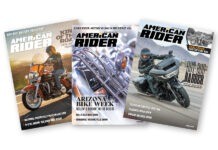
Before we talk about any cultural clashes we need to understand the cultures that are involved within the realm of motorcycles. Webster defines culture as the sum of attitudes, customs and beliefs that distinguishes one group of people from another. Culture is transmitted through language, material objects, ritual, institutions, and art from one generation to the next. So sometime in the early 1900s soon after the introduction of the two-wheeled mode of transportation was the beginning of the motorcycle culture. This period was all-encompassing; the way riders dressed, the destinations they rode to, the way they raced and the places they hung out.
Soon after World War II ended, the motorcycle culture fostered the biker culture with new attitudes, customs and beliefs. These riders no longer cared for the formal dress and rules of the traditional AMA riders. In the ’60s there was a rebellious revolution among society in general which flowed over into the motorcycle world creating the chopper culture. The chopper culture appealed to a broad audience that recognized the chopper as an art form but more importantly a sign of rebellion from the societal norms of the time. As custom styles evolved in the ’70s and ’80s the American V-twin created an aftermarket industry around the motorcycle art form that was the beginning of the custom culture. The custom culture is an expansion of not only the art form to include any chassis and drivetrain configuration but a tribute to the lifestyle and camaraderie that defied the establishment.
Early motorcycle culture was very formal. Each group had their own uniform, so to speak, that members were expected to wear. The spats, jodhpurs and jackets were often color matched with logos and lettering to identify a particular riding group. It was not uncommon for a group to show up in force to support the racers among them. Almost everyone was a member of the AMA which was formed in 1924 bringing rules and organization to the dominant racing scene.
There was a common understanding and camaraderie among the fearless who ventured out on the two-wheel motorcycle creations of the day. It was hearty group that continued to ride and race motorcycles in the wake of cheap mass-produced automobiles. It wasn’t till post-World War I that any motorcycle of note incorporated a countershaft gearbox, chain drive and a kick start. Imagine not having to bump start your ride every time you went for a ride.
World War II began in 1939 and ended in in 1945. The daily trauma service personnel lived through created a new realization for many young and restless returning veterans. When they got back stateside they did not want to settle down to a job and family like their fathers. They were free spirited and wanted to ride motorcycles to release an energy and anxiety created by that devastating war. They also did not want to wear any more uniforms or ride their fathers’ fully-accessorized motorcycles. Many of these young men headed out wearing engineer boots, jeans and a leather pilot’s jacket. They stripped down their motorcycles, cutting back, bobbing their fenders and making sissy bars out of table legs to carry their pack rather than sporting saddlebags. Most ran solo seats as they ventured across America with no particular destination. As they discovered each other in their travel, many formed clubs. The AMA touted that 99 percent of motorcyclists were law abiding, labeling these clubs as outlaws or 1 percenters, thus the creation of the biker culture.
The chopper culture was kind of an extension of the biker culture without the organization of a club. Things were changing fast in the ’60s and teens were looking for ways to rebel. Rock ’n’ roll, drugs and choppers provided the necessary channel to display a lack of respect for authority. Choppers started where the bobbers of the post-war riders left off. High handlebars, no front fenders, stretched front ends and small tanks attributed to this new minimalist look.
The first choppers were cobbled together from Ford radius rods to extend springer front ends, table legs made great sissy bars and handlebars and lighter and smaller Sportster parts completed the look. Frames were raked with wedges stuffed behind the steering head and many other not-so-safe modifications were experimented with. The important thing was to hand build a bike that could not be bought at the local dealership. As time went on choppers were recognized as an art form. As with anything that grows to be accepted, companies started producing parts for builders to purchase, i.e., stretched frames and extended front ends. This was the beginning of the American V-twin aftermarket.
The custom aftermarket evolved into proven and engineered parts that were much safer. There began the question of builder versus assembler. There was such a plethora of custom parts in the ‘90s that many choppers just became an assembly of purchased parts. A new generation of customizers went back to the ways of the original choppers, building their individual components to create one-off expressions of motorcycle customization. Turn-of-the-century economic pressures of a bad economy forced these builders to seek alternative drivetrain configurations beyond the desirable V-twin, thus the custom culture continues the tradition with a focus on form and function. Along with the appreciation of craftsmanship came a desire for a new type of social gathering without so much commercialism.
These cultural changes in the world of motorcycling have caused many differences of opinion. Metric versus V-twin, touring versus cruising, even fat tire against skinny tire debates go on over cold beers in garages all over the place. The one thing we need to remember from our earliest motorcycle culture is we need to all stick together no matter what we ride or how we build. Differences are what makes this the world of motorcycling so great but together, and only together, is the way motorcycling will grow and prosper, allowing us to transmit our culture to future generations.

















